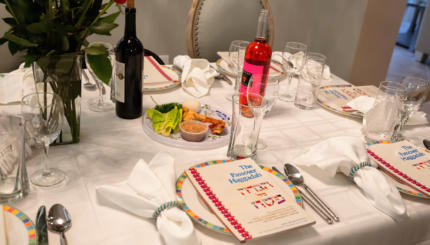Each year, Jewish children around the world learn the Four Questions. After all the image of the small child chanting their way through the Four Questions is one of the most endearing images of the Passover seder. The image is so strong that for many it automatically conjures music and words. This simple piece of the Haggadah liturgy is one the first Jews learn but few of us know about the history of this text and the music that has now become the classic tradition!
When is Passover 2016? Click here to find out!
The Four Question come down to us through the generations. The original Ma Nishtana (Why Is This Night Different?) questions found in the ancient codes of law, the Mishnah and subsequently in variations in the Talmud. Included in these early versions was a question about roasting the Passover sacrifice — which was the practice when the Holy Temple stood in Jerusalem. As the Temple rites faded from memory, the question about sacrifice was replaced with a question about leaning while eating.
The order in which we find the Four Questions in most modern American Haggadahs, follows the Ashkenazi custom. It starts with matzah vs. bread, moves on to maror/bitter herbs, considers double dipping and concludes with reclining. But the Ma Nishtana order in the Sephardi, Mizrahi and Yemenite tradition is a little different. They begin with double dipping, then go on to matzah, come round to maror/bitter herbs and similarly conclude with reclining.
Another notable difference between the historic Ashkenazi and Sephardi/Mizrahi customs around the Four Questions was language. In Yiddish-speaking Ashkenazi communities, the Ma Nishtana were traditionally sung in Yiddish. Sephardi and Mizrachi Jews, by contrast, chanted them in Hebrew and not in Ladino or Judeo-Arabic.
READ: Jewish Languages, From Aramaic to Yiddish
The tune that today is nearly universal is a modern invention and speaks to the Zionist vision to create a new Jewish culture. It was composed by Ephraim Abileah. Abileah was born in Russia in 1881 and was originally called Leo Nesviski. The son of a cantor and a gifted musician, he came to value music as integral to Jewish life and founded The Society for Jewish Folk Music in St. Petersberg. But as Nesviski took to the Zionist vision of a homeland for all Jews in the land of Israel, he made his way there in 1922.
Understanding the power of music in culture, Abileah became part of a movement that composed music that like his new name, would move away from the culture of Diaspora and create a new sound for a new vision of Judaism. In 1936, he composed an oratorio called “Chag Ha-Cherut,” the holiday of freedom. The work was a modern Zionist Passover work that told the story of the Exodus.
While “Chag Ha-Cherut” was performed in full only once, the tune for the Ma Nishtana became a global Jewish standard. In many ways this short simple melody harnessed the power of folk music and achieved what Abileah set out to do. He created a new version of the Four Questions that is today sung by Jews in all parts of the world. This Israeli version has supplanted the Yiddish version nearly completely and is even sung in many Sephardi and Mizrachi homes as well and even by the Jews of Uganda! So while his oratorio may have failed, Abileah succeeded in creating an enduring new vision of global Passover folk music.
READ: Where to Find Songs for Your Passover Seder
You too can sing along to Abileah’s version of Ma Nishtana:
Ashkenazi
Pronounced: AHSH-ken-AH-zee, Origin: Hebrew, Jews of Central and Eastern European origin.


